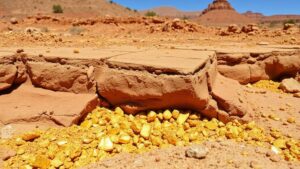Spotting Key Alteration Minerals Like Sericite in Copper Systems
Spotting Key Alteration Minerals Like Sericite in Copper Systems
Detecting and understanding alteration minerals such as sericite is crucial in the exploration and development of copper systems. Recognizing these minerals can provide significant insights into the geological processes that affect mineral deposits, aiding in the classification, exploration, and extraction of copper resources.
Understanding Alteration Minerals
Alteration minerals are secondary minerals that form as a result of chemical changes in the primary minerals within a rock. These changes are usually associated with hydrothermal processes, which play a vital role in the formation of copper deposits. Sericite, a fine-grained, micaceous mineral, is frequently found in association with porphyry copper systems and can indicate productive mineralization as it often forms in the presence of hydrothermal fluids.
Sericite: Characteristics and Formation
Sericite is a type of muscovite that typically appears as a white or light-colored, flaky material. It is formed through the alteration of feldspar and other silicate minerals when exposed to hydrothermal fluids at elevated temperatures. The presence of sericite can be indicative of various geological conditions and is commonly associated with:
- Low-grade metamorphism
- Hydrothermal alteration
- Weathering of feldspars
The presence of sericite can signify that copper-bearing minerals such as chalcopyrite are nearby, thus making it an essential target mineral during exploration.
Identifying Sericite in Field Studies
Spotting sericite requires a keen eye during fieldwork and sample examination. Geologists typically use the following methods to identify sericite and other key alteration minerals:
- Semi-quantitative X-ray diffraction (XRD): This technique helps in identifying and quantifying sericite within rock samples.
- Thin section petrography: Analyzing the mineral composition under a polarizing microscope allows for the identification of sericites characteristic bipyramidal shapes and transparency.
- Scanning electron microscopy (SEM): This advanced imaging technique can provide detailed images of sericite morphology and texture.
Case Studies: Successful Discovery through Sericite Analysis
There have been significant discoveries in copper systems directly linked to the identification of sericite. One example is the Los Pelambres copper mine in Chile, where detailed mineralogy studies revealed a well-defined sericitic alteration zone surrounding the main mineralized body. As a result, initial drilling targets were adjusted based on the mapping of sericite presence, ultimately increasing the wealth of copper extracted from the site.
Another case is the Questa molybdenum-copper deposit in New Mexico, where sericite was identified in the alteration halo, signaling potential areas rich in copper. Studies determined that these sericitic zones corresponded closely with higher-grade mineralization, directing further exploratory drilling in those intervals.
Statistical Insights: The Value of Alteration Mineral Studies
Research indicates that approximately 50-70% of the world’s copper is found in porphyry deposits, where alteration mineralogy significantly impacts exploration success. Studies suggest that mineralogical and alteration studies can enhance the probability of discovering economically viable copper deposits by up to 25%. These statistical insights underline the importance of systematic approaches to identifying alteration minerals like sericite.
Conclusion and Actionable Takeaways
In summary, the identification of alteration minerals such as sericite serves as a fundamental aspect of exploring copper systems. By recognizing the indicators of hydrothermal alteration, geologists can better target their efforts in mineral exploration. The use of modern analytical techniques and understanding past case studies can lead to more efficient and successful copper mining operations. In applying this knowledge, geologists and mining companies should:
- Incorporate mineralogical assessments in initial exploration phases.
- Use advanced techniques such as XRD and SEM for accurate identification.
- Analyze previous case studies to inform drilling strategies and maximize resource recovery.



